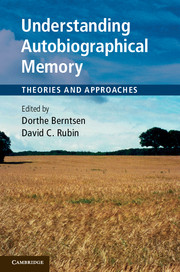Book contents
- Frontmatter
- Contents
- List of figures
- List of tables
- List of contributors
- Preface
- Acknowledgements
- 1 Introduction
- Part I Approaches to the study of autobiographical memory
- Part II Neural studies of autobiographical memory
- 6 The contribution of research on autobiographical memory to past and present theories of memory consolidation
- 7 Functional neuroimaging of autobiographical memory
- Part III Social and cultural aspects of autobiographical memory
- Part IV Development of autobiographical memory from infancy to old age
- Part V Evolution and basic processes of autobiographical memory
- Part VI Discussion
- Index
- References
7 - Functional neuroimaging of autobiographical memory
Published online by Cambridge University Press: 05 November 2012
- Frontmatter
- Contents
- List of figures
- List of tables
- List of contributors
- Preface
- Acknowledgements
- 1 Introduction
- Part I Approaches to the study of autobiographical memory
- Part II Neural studies of autobiographical memory
- 6 The contribution of research on autobiographical memory to past and present theories of memory consolidation
- 7 Functional neuroimaging of autobiographical memory
- Part III Social and cultural aspects of autobiographical memory
- Part IV Development of autobiographical memory from infancy to old age
- Part V Evolution and basic processes of autobiographical memory
- Part VI Discussion
- Index
- References
Summary
Autobiographical memory (AM) refers to memory for events from our own personal past. In the last decade there has been an explosion in the number of functional neuroimaging studies of AM, which is best exemplified in the number of reviews on this topic, varying from those focusing on the core regions involved in AM retrieval and methodological challenges (Maguire, 2001; Svoboda, McKinnon, and Levine, 2006), to emphasizing task-related differences in AM versus laboratory memory studies (Gilboa, 2004; McDermott, Szpunar, and Christ, 2009) or highlighting task-invariant patterns of activations common to AM and other similar tasks, such as imagining the future (e.g., Buckner and Carroll, 2007; Hassabis and Maguire, 2007; Schacter, Addis, and Buckner, 2007; Spreng and Grady, 2010). Functional neuroimaging studies of AM are important because they can investigate the neural correlates of processes that are difficult to study in laboratory stimuli (Cabeza and St. Jacques, 2007; St. Jacques and Cabeza, 2012). An AM researcher, however, may still question what exactly such studies contribute to our theoretical understanding of personal memory. The present chapter considers three integral aspects of AM where functional neuroimaging data provide us with important insights. First, functional neuroimaging studies can inform our understanding of the complex retrieval processes in AM by allowing the examination of separable phases of memory retrieval. Second, such studies can distinguish the specific role of self-reference in AM and how it potentially directs memory construction. Third, functional neuroimaging studies of AM offer compelling ideas regarding the role of recollection in the timing and interaction of multiple component processes during retrieval, as well as the potential contribution of familiarity processes in recognizing autobiographical experiences. Before turning to these aspects, I first briefly review the main functional neuroimaging methods for investigating AM and the core brain regions typically involved in AM retrieval, which will be relevant to the studies discussed here.
Information
- Type
- Chapter
- Information
- Understanding Autobiographical MemoryTheories and Approaches, pp. 114 - 138Publisher: Cambridge University PressPrint publication year: 2012
References
Accessibility standard: Unknown
Why this information is here
This section outlines the accessibility features of this content - including support for screen readers, full keyboard navigation and high-contrast display options. This may not be relevant for you.Accessibility Information
- 13
- Cited by
